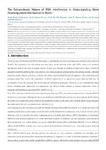Plant Genomics. Chapter 7: The Extraordinary Nature of RNA Interference in Understanding Gene Downregulation Mechanism in Plants

View/
Date
2016Author
Ricaño-Rodríguez, Jorge
Adame-García, Jacel
Portilla-Vázquez, Silvia
Metadata
Show full item recordAbstract
Gene silencing (also known as ribonucleic acid [RNA] interference [RNAi] or interfering RNA) was first recognized in plants and is considered one of the most significant discoveries in molecular biology in the last several years. These short-chain ribonucleic acid molecules regulate eukaryotic gene expression. The phenomenon involves a process that promotes RNA transcripts degradation through complementarity between RNA molecules and RNAi transcripts, resulting in the reduction of their translation levels. There are two principal classes of regulatory RNA molecules: small interfering RNAs (siRNA) and microRNAs (miRNA). Both are generated from the cleavage of double-stranded self-complementary RNA hairpins by a DICER enzyme that belongs to the RNase III family. Small RNAs (of about 21–24 nucleotides in size) guide specific effector Argonaute protein to a target nucleotide sequence by complementary base pairing. Thereby, the effector protein complex downregulates the expression of RNA or DNA targets. In plants, cis-regulatory RNAi sequences are involved in defense mechanisms against antagonistic organisms and transposition events, while trans-regulatory sequences participate in growth-related gene expression. siRNA also performs neutral antiviral defense mechanisms and adaptive stress responses. This document is an attempt to scrutinize the RNAi nature in understanding gene downregulation mechanism in plants and some technical applications.
Collections
- Education [806]
